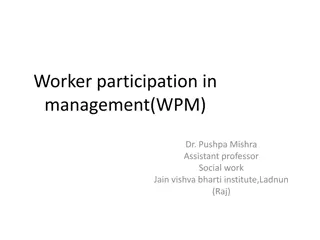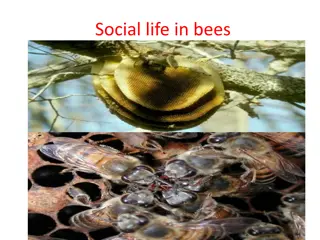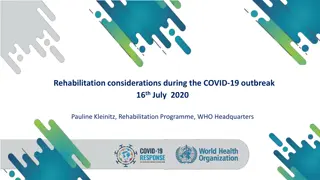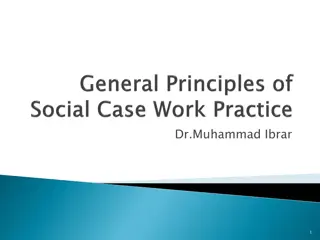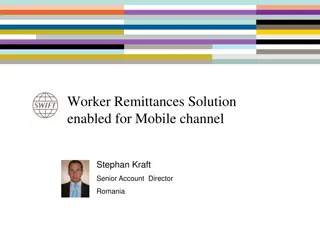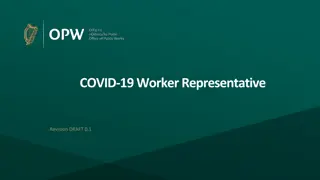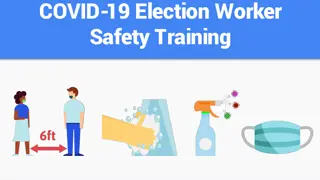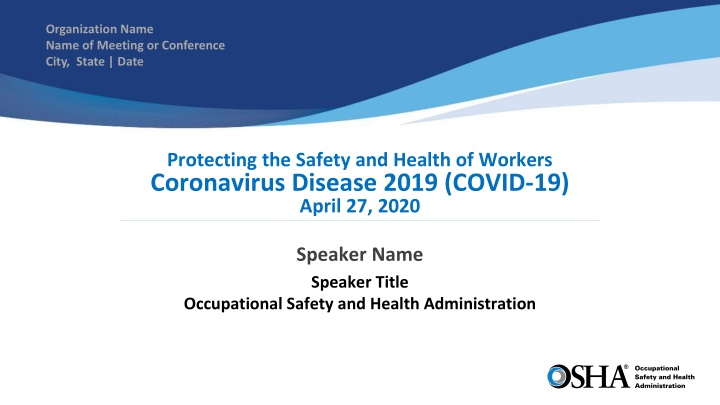
Protecting Worker Health during COVID-19
The impact of COVID-19 on worker safety, learn about the novel coronavirus, its symptoms, and how it differs from other coronaviruses. Stay informed about the current pandemic situation and how COVID-19 spreads. Explore essential information to safeguard workers' health.
Download Presentation

Please find below an Image/Link to download the presentation.
The content on the website is provided AS IS for your information and personal use only. It may not be sold, licensed, or shared on other websites without obtaining consent from the author. If you encounter any issues during the download, it is possible that the publisher has removed the file from their server.
You are allowed to download the files provided on this website for personal or commercial use, subject to the condition that they are used lawfully. All files are the property of their respective owners.
The content on the website is provided AS IS for your information and personal use only. It may not be sold, licensed, or shared on other websites without obtaining consent from the author.
E N D
Presentation Transcript
Organization Name Name of Meeting or Conference City, State | Date Protecting the Safety and Health of Workers Coronavirus Disease 2019 (COVID-19) April 27, 2020 Speaker Name Speaker Title Occupational Safety and Health Administration
What is novel coronavirus? Illustration: CDC / Alissa Eckert & Dan Higgins Coronaviruses are a family of viruses that can cause illness in people. Coronaviruses circulate among animals, including camels, cattle, and cats. SARS-CoV-2, the seventh known human coronavirus and the virus that causes COVID-19, is thought to have jumped species from animals to begin infecting humans. www.osha.gov/coronavirus
How is COVID-19 different from other known coronaviruses? Illustration: CDC / Alissa Eckert & Dan Higgins Several coronaviruses cause common colds, but are not significant threats for most healthy people. Other coronaviruses have caused past outbreaks, including Severe Acute Respiratory Syndrome (SARS) and Middle East Respiratory Syndrome (MERS) each caused by a different coronavirus. SARS-CoV-2 is a distinct coronavirus. www.osha.gov/coronavirus
Signs and symptoms of infection Illustration: CDC / Alissa Eckert & Dan Higgins COVID-19 typically causes mild respiratory illness, but can cause severe disease, including pneumonia-like illness (novel coronavirus-infected pneumonia or NCIP). Typical symptoms include fever, cough, and shortness of breath. Symptoms begin 2-14 days after exposure. www.osha.gov/coronavirus
Current pandemic Latest situation summary: www.cdc.gov/coronavirus/2019-ncov/ More than 1 million cases worldwide. Different parts of the U.S. are seeing different levels of COVID-19 activity. All 50 states have reported cases of COVID-19 to CDC. www.osha.gov/coronavirus
Current pandemic Latest situation summary: www.cdc.gov/coronavirus/2019-ncov/ U.S. COVID-19 cases include: Imported cases in travelers. Cases among close contacts of a known case. Community-acquired cases where the source of the infection is unknown. Most U.S. states are reporting community spread of COVID-19. www.osha.gov/coronavirus
How COVID-19 is spread Person-to-person spread. Latest situation summary: www.cdc.gov/coronavirus/2019-ncov/ COVID-19 is thought to spread mainly through close contact from person-to-person in respiratory droplets from someone who is infected. People who are infected often but not always have symptoms of illness. People without symptoms are able to spread virus. Spread from contact with contaminated surfaces or objects. www.osha.gov/coronavirus
If you have been exposed/infected Prior to seeking treatment, alert your healthcare provider or occupational health clinic if you think you may have COVID-19. Tell your healthcare provider if you have been exposed to someone with the virus and have signs/symptoms of infection, as well as about any recent travel to areas where COVID-19 is spreading. Photo: CDC / Scott Housley www.osha.gov/coronavirus
Diagnosis and treatment Your healthcare provider can determine if you should be tested for COVID-19. There is no vaccine or specific treatment for COVID- 19. Some patients, especially those who become very ill, may require supportive care in a hospital. Photo: CDC / Scott Housley www.osha.gov/coronavirus
Occupational exposure risks OSHA is closely coordinating with CDC, including NIOSH, and other agencies to monitor the ongoing pandemic. The risk of exposure in many workplaces likely reflects the risk to the general public in the community where the workplace is located. Risk increases when workers have frequent, close contact with the general public or other coworkers. Photo: U.S. Navy / Seaman Rob Aylward www.osha.gov/coronavirus
Occupational exposure risks Workers in some sectors may have increased risk of occupational exposure to SARS-CoV-2, including in: Healthcare and Laboratories Emergency response Mortuary services and other deathcare Airline operations Border protection and passenger screening Critical retail operations (e.g., grocery stores, pharmacies) Photo: U.S. Customs and Border Protection / James Tourtellotte www.osha.gov/coronavirus
Occupational exposure risks Workers in other sectors, including some in critical infrastructure, may be at risk because of frequent or long-duration contact with coworkers: Food processing (including meatpacking) Manufacturing Construction Oil and gas Other sectors where workers would typically be within 6 feet of one another www.osha.gov/coronavirus
Existing OSHA standards protect workers from exposure Relevant OSHA requirements Follow existing OSHA standards to help protect workers from exposure to SARS-CoV-2 and infection with COVID-19. Personal Protective Equipment (29 CFR 1910 subpart I), including: PPE General Requirements (1910.132) Eye and Face Protection (1910.133) Respiratory Protection (1910.134) Hand Protection (29 CFR 1910.138) Employers should also remember that OSHA can use the General Duty Clause, Section 5(a)(1), of the Occupational Safety and Health Act to ensure that workers are protected from recognized safety and health hazards that may cause serious harm. Bloodborne Pathogens (29 CFR 1910.1030) Hazard Communication (29 CFR 1910.1200) Recordkeeping (29 CFR part 1904) www.osha.gov/coronavirus
Exposure risk very high Healthcare workers (e.g., doctors, nurses, dentists, paramedics, EMTs) performing or present for aerosol-generating procedures (e.g., intubation, cough induction procedures, bronchoscopies, CPR, some dental procedures and exams, invasive specimen collection) on known or suspected COVID-19 patients. Healthcare or laboratory personnel collecting or handling specimens from known or suspected COVID-19 patients. Morgue workers performing autopsies on the bodies of people who are known to have, or suspected of having COVID-19 at the time of their death. www.osha.gov/coronavirus
Exposure risk high Healthcare delivery and support staff (e.g. doctors, nurses, and other hospital staff who must enter patients rooms) exposed to known or suspected COVID-19 patients. (While NO aerosol generating procedures are being performed.) Medical transport workers (e.g., ambulance vehicle operators) moving known or suspected COVID-19 patients in enclosed vehicles. Mortuary workers involved in preparing the bodies of people who are known to have, or suspected of having COVID-19 at the time of their death. www.osha.gov/coronavirus
Exposure risk medium Jobs that require frequent (i.e., more than a few minutes) and/or close (i.e., within 6 feet) contact with people who may be infected with SARS-CoV-2, but who are not known or suspected COVID-19 patients. Examples include: Critical retail workers, such as those in pharmacies and grocery stores. Transit workers, such as bus drivers, subway operators, and taxi drivers. Workers in other transportation operations. www.osha.gov/coronavirus
Exposure risk low (caution) Jobs that do not require contact with people known to be, or suspected of being infected with SARS-CoV-2 nor frequent close contact with (within 6 feet) of the general public. Workers in this category have minimal occupational contact with the public and other coworkers. www.osha.gov/coronavirus
OSHA enforcement OSHA: OSHA enforcement authority Typically responds to emergencies, including disease outbreaks, in a technical assistance posture. During emergency response operations, even when OSHA is operating in a technical assistance and support mode, OSHA standards remain in effect and OSHA retains its ability to enforce the OSHA standards under the OSH Act. Provides compliance assistance to employers to help ensure workers are protected. Provides technical assistance and support to other federal agencies, as well as state/local partners. Enforcement of OSHA standards follows the jurisdiction in place before the emergency, such as in states operating OSHA-approved occupational safety and health programs called State Plans. Implemented interim enforcement plan for investigating COVID complaints, while ensuring the safety of workers, employers, and inspectors. www.osha.gov/coronavirus
OSHA enforcement discretion Memorandum Effective Healthcare Respiratory Protection Annual Fit-Testing for N95 Filtering Facepieces During the COVID-19 Outbreak March 14, 2020 - present OSHA has provided enforcement discretion for some of its requirements, including: Respiratory Protection standard (29 CFR 1910.134) Other health standards with respirator requirements Recording and Reporting Occupational Injuries and Illness (29 CFR Part 1904) Enforcement Guidance for Respiratory Protection and the N95 Shortage Due to the 2019 Novel Coronavirus Disease (COVID-19) Pandemic April 3, 2020 present Enforcement Guidance for Use of Respiratory Protection Equipment Certified Under Standards of Other Countries or Jurisdictions During the COVID-19 Pandemic April 3, 2020 - present Expanded Temporary Enforcement Guidance on Respiratory Protection Fit-Testing for N95 Filtering Facepieces in All Industries During the COVID-19 Pandemic April 8, 2020 - present Enforcement Guidance for Recording Cases of Coronavirus Disease 2019 (COVID-19) April 10, 2020 present Enforcement Guidance on Decontamination of Filtering Facepiece Respirators in Healthcare During the COVID-19 Pandemic April 24, 2020 present www.osha.gov/coronavirus
OSHA guidance OSHA has developed a variety of guidance materials for workers and employers on how to stay healthy during the pandemic. OSHA.gov/coronavirus includes information on implementing the hierarchy of controls when workers have specific exposure risks. www.osha.gov/coronavirus
OSHA guidance OSHA Alerts COVID-19 Guidance for the Construction Workforce COVID-19 Guidance for the Manufacturing Industry Workforce COVID-19 Guidance for the Package Delivery Workforce COVID-19 Guidance for Retail Workers Prevent Worker Exposure to Coronavirus (COVID-19) www.osha.gov/coronavirus
OSHA guidance OSHA and CDC Interim Guidance for Meatpacking and Processing (beef, poultry, and pork) Guidance includes information on: o Cleaning of shared meatpacking and processing tools; o Screening employees for the coronavirus before they enter work facilities; o Managing workers who are showing symptoms of the coronavirus; o Implementing appropriate engineering, administrative, and work practice controls; o Using appropriate personal protective equipment; and o Practicing social distancing at the workplace. www.osha.gov/coronavirus
OSHA guidance Clockwise from L: public domain; WikimediaCommons; CDC/Kimberly Smith & Christine Ford OSHA guidance helps employers comply with OSHA standards. Guidance is based on anticipated hazards and risks, and incorporates standard, contact, and airborne precautions, and use of face/eye protection. Guidance should be adapted based on employer s hazard assessment and workers tasks. www.osha.gov/coronavirus
OSHA guidance For all workers, regardless of specific exposure risks: Practice good and frequent hand hygiene. Follow good cough/sneeze etiquette. Avoid touching the eyes, nose, or mouth with unwashed hands. Avoid close contact with people who are sick. Photo: U.S. Department of Defense www.osha.gov/coronavirus
OSHA guidance Employers should implement protocols for regularly cleaning and disinfecting high-touch surfaces in the work environment. Wipe down surfaces such as door push bars, shopping carts, points of sale, chairs in waiting areas, and other areas that customers, visitors, or workers frequently touch. Follow manufacturer s instructions for use of all EPA-approved cleaning and disinfection products. CDC provides detailed guidance for environmental cleaning and disinfection. www.osha.gov/coronavirus
OSHA guidance Train all workers about their risk of occupational exposure to COVID-19 as well as on what to do if they have traveled to high-risk areas or been exposed to possible cases. For workers at particular risk of exposure (e.g., in healthcare, others), discuss: Sources of exposure to the virus and hazards associated with that exposure. Appropriate ways to prevent or reduce the likelihood of exposure, including use of engineering and administrative controls, safe work practices, and PPE. Some OSHA standards (e.g., BBP, PPE) require worker training. www.osha.gov/coronavirus
OSHA guidance For U.S. workers and employers of workers with potential occupational exposures to COVID-19: Identify and isolate suspected cases. Implement other precautions appropriate for the worksite and job tasks, and according to the hierarchy of controls. www.osha.gov/coronavirus
OSHA guidance What should standard, contact, and airborne precautions consist of in workplaces where workers may be exposed to COVID-19? OSHA guidance breaks this down by worker type. Engineering controls, such as isolation rooms and other physical barriers, can limit most workers exposures. Administrative controls and safe work practices include measures such as limiting access to patient care areas, effective sharps management, and worker training. PPE may include gloves, gowns, goggles or face shields, and N95 or better respirators. www.osha.gov/coronavirus
OSHA guidance recordkeeping exposures to COVID-19 COVID-19 can be a recordable illness if a worker is infected as a result of performing their work-related duties. However, employers are only responsible for recording cases of COVID-19 if all of the following are met: The case is a confirmed case of COVID-19 (see CDC information on persons under investigation and presumptive positive and laboratory-confirmed cases of COVID-19); The case is work-related, as defined by 29 CFR 1904.5; and The case involves one or more of the general recording criteria set forth in 29 CFR 1904.7 (e.g., medical treatment beyond first-aid, days away from work). OSHA is providing enforcement discretion around recordkeeping for most sectors. Visit OSHA s Injury and Illness Recordkeeping and Reporting Requirements page for more information. www.osha.gov/coronavirus
Worker Rights All workers have the right to: Raise a safety or health concern with their employer or OSHA, request personal protective equipment, or report a work-related injury or illness, including COVID-19. Receive information and training on job hazards in their workplace.
Whistleblower Protections under the OSH Act Employers cannot retaliate (fire, lay off, demote, etc.) against employees for engaging in activity protected under the OSH Act. Protected activity includes: Requesting personal protective equipment Wearing personal protective equipment Reporting a work-related injury or illness, including COVID-19, to an employer or OSHA Reporting an unsafe condition to an employer or OSHA Requesting guidance on workplace safety from an employer, OSHA, or other government entity
Work Refusals under the OSH Act Under the OSH Act, employees have the right to refuse to perform an assigned task if they: Have a reasonable apprehension of serious injury or death arising from a hazardous condition at the workplace; and Refuse in good faith to expose themselves to the hazardous condition; and Have no reasonable alternative; and Have insufficient time, due to the urgency of the situation, to eliminate the danger through resort to regular statutory enforcement channels (i.e., contacting OSHA or an OSHA State Plan); and Where possible, sought from their employer, and were unable to obtain, a correction of the dangerous condition.
For continual updates Visit OSHA s website to sign up to receive OSHA information: QuickTakes biweekly newsletter Tip of the Day www.osha.gov/contactus Follow OSHA on social media Twitter: @OSHA_DOL Facebook: Follow the Department of Labor page www.osha.gov/coronavirus
Questions? [Speaker] OSHA Directorate of Technical Support and Emergency Management OSHA [Directorate/Region/Area] Phone: 202-693-2300 Email: Phone: www.osha.gov/coronavirus
www.osha.gov 1-800-321-OSHA (6742)

